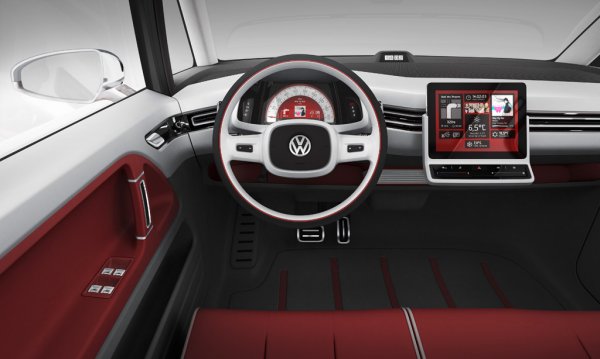Connected cars speed into the future

Modern cars are fast turning into smart web-connected “mobile platforms” that allow you to tweet, find restaurants and avoid accidents – while taking you from A to B.
The rapid development of mobile phone and computer technologies is driving innovation in- and outside vehicles. A raft of next-generation models are currently on show at the 81st Geneva Motor Show.
Imagine the near future on a cold winter day. Using a special iPhone application you remotely start your car, turn on the defroster and set the air conditioning to hot.
Don’t worry if you cannot remember where you parked your car in that busy car park; a click on the app can activate the horn and headlights. Once inside, the car’s navigation system automatically detects the destination by synchronising with your Bluetooth-connected phone and plans the best route or locates the nearest electric charging station or parking space.
And of course your favourite music playlists, videos or email, facebook and Twitter accounts are just a click away on the hi-tech in-car console.
These futuristic features are not that far away. Intelligent networking and integrated driving are some of the buzz words being heard in Geneva this week, alongside the ubiquitous e-mobility.
“Connected living is a reality,” Dirk Wisselmann, project leader for BMW’s Connected Drive concept, told swissinfo.ch. “Today we are in a phase where we are combining information systems, the internet and driver assistance to improve comfort, infotainment and driver safety.”
BMW was one of the first carmakers to merge information technology in vehicles; it installed an integrated navigation system back in 1994. Connected Drive now has 50 high-tech functions from voice-activated facebook and Twitter to a night-vision camera and display to warn of nearby pedestrians.
Voice-activated technology
Other firms are also investing heavily in new telematics. Ford, General Motors and Volvo offer similar iPhone applications to “My BMW Remote”.
In Geneva Ford is showing off its Sync in-car information and entertainment system, in partnership with Microsoft, which it plans to launch in Europe in 2012.
The voice-activated technology, available in 19 languages, gives access to the contents of a driver’s iPhone.
The Saab PhoeniX concept car, which launches the new IQon infotainment system, made its world debut in Geneva.
Using Google’s Android operating system, IQon connects to the internet when the car’s ignition is switched on. A touch screen allows drivers to manage email, locate restaurants and shops and provides access to audio and entertainment streaming, online navigation and on-board music storage.
Connected hub
Volkswagen is showing off its new Bulli concept, based on the original iconic T1 camper van. Apple’s iPad plays an integral role in the centre of the new electric vehicle, serving as the car’s stereo, navigation, phone and temperature control system.
“We want a car that satisfies all our needs,” Seung Suk Yang, president of the Hyundai Motor Company, told a news conference in Geneva. “It’s a workplace, a home and a connected hub for our busy lives.”
Hyundai recently announced it was entering the world of telematics with the introduction of Blue Link in the US. Similar to the General Motors subsidiary OnStar, the Blue Link system provides navigation, remote door-locking and unlocking, hands-free voice-text messaging and a raft of other features.
Europe will get a similar system with next-generation satellite navigation and onboard diagnostics in about two years. The company is presently trying to iron out infrastructure problems with Vodaphone and other network service providers, explains Helmut Weixner, head of engineering design at Hyundai Motor Europe.
“In-car technologies are the future; we are strongly working on different features, including car-to-car interaction,” Weixner told swissinfo.ch.
Information overload
Amid an avalanche of new hi-tech features, car developers are quick to offer reassurance against the potential dangers of information overload and facebooking behind the wheel.
“The car acts as a filter function,” said Wisselmann. “You get just the right information at the right time. Our priority is a safe trip.”
Weixner agrees: “We want to make things as simple and user friendly as possible.”
But it is not easy meeting these additional demands, says Oliver Sieghart, head of interior design at Mini.
“We have customers who are really keen on all these new features. It’s understood that consumers want to integrate things from their smart phones and from home, and don’t want to miss out on this technology in their car.
“But a car is a car and not a home computer. There always needs to be a time to be quiet and concentrate on the driving,” he told swissinfo.ch.
On March 3, Swiss President Micheline Calmy-Rey opens the 81st Geneva International Motor Show, which runs until March 13.
Some 700,000 people are expected to pour through the doors of the huge Palexpo exhibition halls to ogle the new got-to-have cars, which include 170 world and European premieres.
These include: Ferrari FF, the Hyundai 1040, Ford B-Max, VW Golf cabriolet BlueMotion, new Lancia Ypsilon, Range Rover Evoque, new Peugeot 308, Honda Jazz hybrid and Subaru Trezia.
Around 40 per cent of visitors travel from outside Switzerland, with many from neighbouring Germany, France and Italy.
The organisers claim that the Geneva Motor Show generates SFr300 million ($254.3 million) in direct and indirect income.
Auto industry consultancy IHS is forecasting a 6.3 per cent increase in total global passenger car volumes for 2011. But some motor executives believe it is too early for optimism as oil prices continue to rise due to unrest in energy-producing nations in the Middle East.

In compliance with the JTI standards
More: SWI swissinfo.ch certified by the Journalism Trust Initiative















You can find an overview of ongoing debates with our journalists here . Please join us!
If you want to start a conversation about a topic raised in this article or want to report factual errors, email us at english@swissinfo.ch.